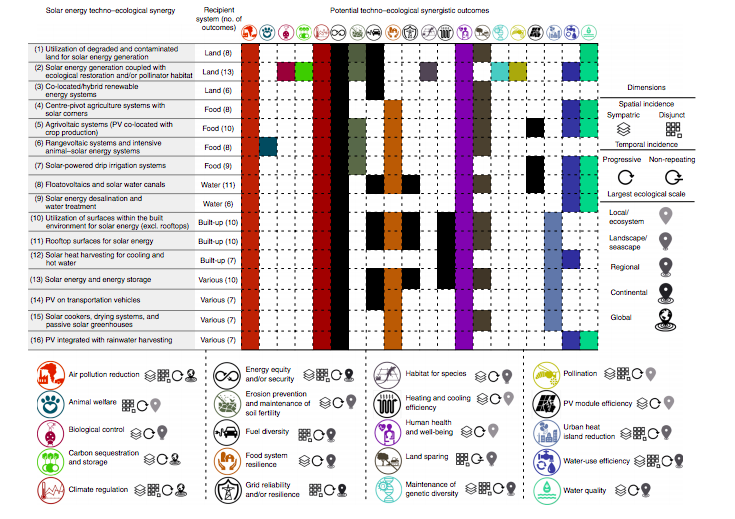With clean energy access and conservation of ecosystems and biodiversity high up the global sustainability agenda, understanding better – and quantifying – the benefits of solar could unlock an array of positive outcomes.
A study by the UC Davis, the Center for Biological Diversity and 11 other organizations has listed the advantages of solar and offers a new framework for analyzing PV projects to better understand their benefits.
The study, published in Nature Sustainability, identified 20 overlooked advantages of solar energy, ranging from carbon sequestration to improvements to pollinator habitats.
The researchers found, when ‘techno-ecological synergies’ (TESs) were studied it was possible to quantify resources taken from an environment – for example water withdrawal and habitat loss – and materials released into it, such as CO2 emissions and nutrient runoff. Jordan Macknick, a researcher at the U.S. National Renewable Energy Laboratory, said: “Solar projects, when done using the principles of TESs have the potential to improve air, water and soil resources in addition to producing clean energy.”
Solar-sustainability win-win
The researchers described examples of 16 solar energy technological-ecological synergies and 20 of their potential outcomes to demonstrate such crossovers were achievable in many environments and were capable of producing beneficial technological outcomes – such as raised PV module efficiency and grid reliability – as well as ecological ones.
The scientists argue PV projects developed with such crossover benefits in mind can mitigate, or even avoid, environmental degradation. Solar project development carried out without such benefits in mind proceeds without full consideration of the supply and demand of ecosystem goods and services, resulting in industrial waste or environmental degradation.
Trade-offs commonly emerge for decision makers concerning the use of land for solar energy development. Techno-ecological benefits can help guide development towards optimum landscape sustainability, the study stated. Optimizing land resources by installing solar energy infrastructure on degraded land or co-locating solar with other renewables infrastructure can maximize energy production and land use. For instance, researchers identified ‘superfund’ sites in the U.S. which could be used to generate more than 1.6 million GWh of solar energy annually.
Co-locating food or energy crop production and solar is another win-win crossover. ‘Agrovoltaic’ systems can ensure land is used to the full. For example, shade-tolerant crops can thrive in the shadows of solar panels, reducing evaporation and improving water usage. ‘Rangevoltaic’ systems – solar co-located with livestock and its associated infrastructure, notably on grazing areas – can provide numerous techno-ecological benefits. Yesterday, New York-based renewables and storage investor C2 Energy Capital announced it was preparing to roll out a grazing program which saw a herd of sheep keep down growth at a 7 MW solar site operated by Florida utility JEA. C2, which also has a wildflower planting trial solar site, said it would expand the grazing system to ten sites covering more than 300 acres and hosting 79 MW of solar power generation capacity across three U.S. states.
Solar in animal-intensive environments such as dairy farms could offer similar positive outcomes in areas including food security and animal welfare.
Floating solar
In regions where land is scarce, floating solar can be an appealing option. The technology can reduce water evaporation and algae growth and can be integrated on hydroelectric reservoirs. For example, the 1 MW canal solar project in Gujarat, India prevents the evaporation of 34 million gallons of water per year.
Solar arrays in the built environment require no additional land. As has long been known, solar rooftops have insulating effects that can confer energy savings and improve health and comfort.
There are also four solar techno-ecological crosssovers which can be integrated into a variety of environments. Solar-plus-storage; electromobility – including air and seaborne transport; solar greenhouses; and PV rainwater collection all offer multiple benefits.
PV-wildlife symbiosis
“Solar energy has way more benefits than most people imagine,” said Greer Ryan, a renewable energy and research specialist at the Center for Biological Diversity and co-author of the paper. “We’re hoping utilities, regulators and legislators will now have a better sense of the importance of solar energy. That will lead to the expansion of rooftop solar, more community solar development and lower prices for everyone.”
The study marks the launch of a partnership between the Center for Biological Diversity and its university to advance a “wild energy” future which emphasizes the potential of solar to benefit not only humans but the entire planet.
“The first step in creating a wild energy future is understanding the true value of solar,” said Rebecca R. Hernandez, assistant professor at UC Davis’ John Muir Institute of the Environment, and the paper’s lead author. “By valuing all the benefits of renewable energy we can start to build an energy system that’s beneficial for people, wildlife and wild places.”
This content is protected by copyright and may not be reused. If you want to cooperate with us and would like to reuse some of our content, please contact: editors@pv-magazine.com.





Nice blog to to read.